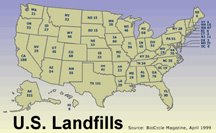Landfill odor prompts statewide warning
The Times-Reporter
BOLIVAR – “We have a big old science project going on here,” commented Richard Regula, Stark County commissioner and chairman of the Stark-Tuscarawas-Wayne Joint Solid Waste Management District Board of Directors.
Regula was referring to information by Kurt Princic, environmental manager, of the Ohio Environmental Protection Agency during Friday’s board meeting. Princic said the odor issue, which is believed to be caused by aluminum dross/saltcake at Countywide Recycling and Disposal Facility in Pike Township of Stark County, has raised a red flag for landfills throughout Ohio that accept the material.
He said the OEPA cautioned Ohio landfills they need to take precautions after receiving a telephone call from the United States EPA about the dross causing a fire and reacting violently when water was run over it at other landfills.
“Countywide accepted between 200,000 and 300,000 tons of aluminum dross/saltcake when Barmet Aluminum at Uhrichsville was cleaned up,” he said. “It all came to Countywide. It is causing the odor problem and generating heat which pushes out the gas. The breakdown of the garbage is at a much faster rate and caused a subsidence problem. The maximum settlement in the original 88 acres of the landfill is 33 feet. The material was buried and water added to it during the recirculation process. The subsidence has not stopped and is at a much more accelerated rate than before, although even if there wasn’t a problem it would still drop 15 to 20 feet causing a sink hole.”
Countywide, owned by Republic Services of Ohio, accepted the dross/saltcake for 10 years but stopped in 2001. The dross is in cells one to four but not in the fifth at the landfill. All other aluminum foundry waste accepted in small quantities was stopped in July 2006, according to Countywide officials.
“Shouldn’t the landfill have known?” Regula asked. “Weren’t they aware of that product just sitting on the ground was not hazardous but when mixed with water it was?”
“The landfill has pumped 14 million gallon of leachate from January through October compared to 12 million gallons for the same period in 2005,” Princic said. “They no longer recirculate leachate, it is removed and taken to another site for processing.”
He said the leachate system was snaked this summer and there is no problem with it. He said the plastic tarp is almost in place on about 25 acres of the original site. It will push gases out through a pipe and into a flare. He said the horizontal movement has been stopped by a berm that has stabilized the area.
Princic explained leachate coming out side slopes of the landfill was caused by gas pressure and causing the odor. He said the bottom of a geomembrane liner is safe at 86 to 120 degrees. He said Countrywide’s liner is 95 to 116 degrees Fahrenheit and would have to be at 266 degrees Fahrenheit for the liner to melt.
Split samples of the groundwater will be taken in November from the site and sent to separate labs for results. Princic said the air quality is still unacceptable. Air samples are taken on a regular basis from equipment on the roof at Bolivar Elementary and a cell tower at Countywide.
Tuscarawas County Commissioner Kerry Metzger asked Robert Frey, geologist and chief of the Health Assessment Unit of the Ohio Department of Health, if studies are available about how to store dross/saltcake in a confined area so it is not hazardous and why Countywide was allowed to recirculate leachate when the dross was in the cells.
Frey said this was the first time he was aware this has happened in Ohio. He said odors can create health problems such as headaches, or nausea.
“People react differently to odors. Females and children are more sensitive. Basically when you breathe a bad odor, it goes to the brain and can cause a person to become anxious and the stress level increases and could cause respiratory problems,” he said.
“What is the chance of this occurring in other cells, and do we know the potential long term health hazards?” Metzger asked. “What are the health issues of the employees at Countywide? Has the Occupational Health and Safety Administration (OHSA) been asked to investigate the situation to make sure workers are safe?”
Tim Vandersall, general manager at Countywide, said no employees work under the plastic tarp or around pipes that carry gas to flares. He said no health issues have been identified with workers. The board agreed to send a letter to OHSA to investigate the matter of any health issues with landfill employees.
Wayne County Commissioner Cheryl Noah told OEPA the subsidence is more rapid than in other landfills. “I am not playing Chicken Little saying the sky is falling – just address this.”












